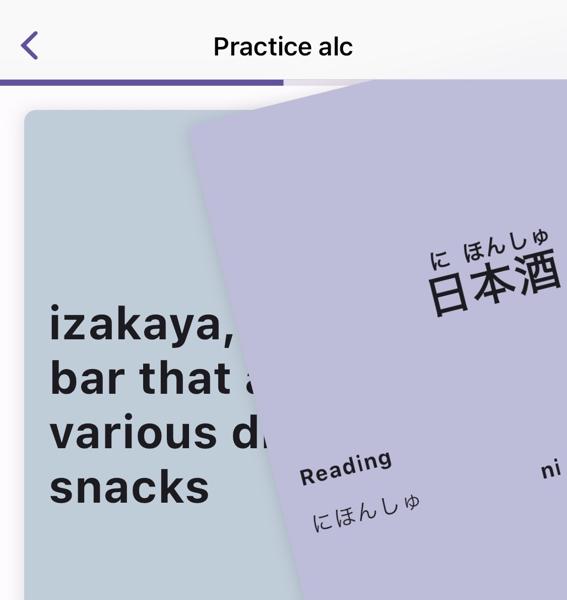Spaced Repetition with Adaptive SM-2
Spaced repetition is a learning technique that increases intervals of time between subsequent reviews of previously learned material, based on the psychological spacing effect. It’s a strategy that optimizes memorization and recall efficiency. In language learning, this translates to remembering more with less effort.
Anki, FSRS, and SuperMemo SM-17 strut with the confidence of complex algorithms and intricate customization options. Then there’s SakeSaySo, more like the unassuming local izakaya than a flashy nightclub. We have opted for a more laid-back approach, keeping it simple – because who really wants to make recall quality decisions while slurping drinks?

Flash-cards in the SakeSaySo app v1.1.6.
Screenshot: SakeSaySo / CC-BY-CA
When comparing SakeSaySo’s adaptive version of the SM-2 algorithm to Anki, FSRS, and SuperMemo SM-17, it’s essential to understand our rationale. These well-established systems offer comprehensive and complex algorithms that cater to dedicated learners seeking deep customization and control over their learning process.
- Anki: The versatile powerhouse of SRS, Anki offers intricate customization, appealing to learners who relish fine-tuning their learning experience.
- FSRS: FSRS for Anki uses advanced algorithms to optimize memory prediction and scheduling. Ideal for data-driven learners, it’s akin to selecting the perfect saké based on intricate taste notes.
- SuperMemo SM-17: Representing the cutting edge in SRS, SM-17 is based on years of research and offers highly optimized interval timing. It’s ideal for users who seek the most scientifically advanced method.
Keep It Simple and Sip Sake Straight
SakeSaySo’s version of the SM-2 algorithm is designed to be more straightforward. We recognize that while we may not match the depth of Anki or the complexity of SuperMemo SM-17, our focus is on providing a user-friendly interface and an algorithm that’s easy to understand and improve upon.
We understand that after a long day, the last thing you want to do is rate how well you remember a Japanese phrase on a scale. We’ve tailored the SM-2 algorithm to adjusting review intervals based on the speed of recall and personalize that recall speed to what’s ’normal’ for the learner. If a user recalls a word quickly, within a standard deviation of their mean, the interval before the next review is extended, and vice versa. This adaptive approach aims to optimize learning efficiency without overwhelming the user. It also adjusts over time as the user’s recall speed changes.
We’re the first to admit that we won’t match the advanced analytics of FSRS or the personalization of SuperMemo SM-17. But then again, we’re not trying to. Our goal is to take decision-making off your plate while keeping our side simple. Learning Japanese shouldn’t feel like a sommelier exam – it should be as relaxing as enjoying a smooth glass of Junmai Daiginjo.
Join Us
We’re on a journey to make learning Japanese as enjoyable as your favorite drink. We might not have all the answers, but we’re committed to improving one step at a time. Your feedback is the secret ingredient in our brew. Tell us what works, what doesn’t, and how we can make SakeSaySo better.
So, pour yourself a glass, kick back, and let’s learn some Japanese!